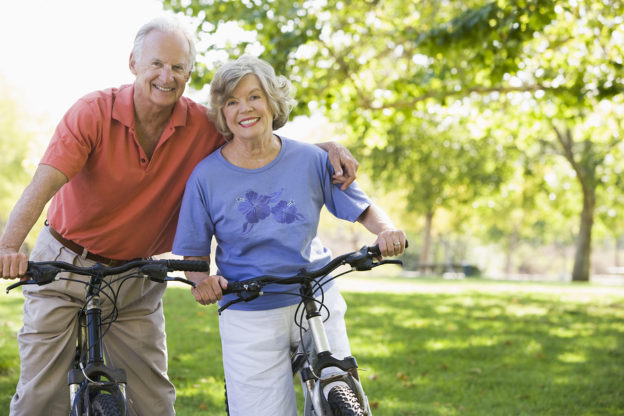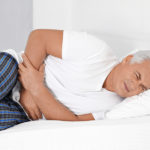By David Blyweiss, M.D., Advanced Natural Wellness
May 27, 2020
It seems like every new decade comes with its own set of health issues.
When I turned 30, I got out of bed and my ankles cracked. When I turned 40, my knees cracked. And when I turned 50, my back cracked…
By the time I turned 60, I just hid under my covers and didn’t get up.
Ha! Just kidding.
I didn’t really notice any huge changes when I turned 50. Perhaps I was a little stiffer with lower muscle mass.
Really, the changes you see in your own body are going to depend heavily on your diet and lifestyle.
I’ve talked before about some of the changes most people experience when it comes to hair loss, hormone production and bathroom habits. Now let’s dive into some ways age 50 may impact the rest of your body.
MD Exposes the Hidden Danger to Your Eyes

When your eyesight starts to fail, it's a real problem. Suddenly you can't go to the grocery store... you can't get to the doctor if you have an emergency... you can't meet your friends for dinner…
Your "regular" doctor doesn't have time to keep up with the latest research. And the same goes for eye doctors. They go to school to learn how to fit you for glasses and contacts, but have no way of preventing the damage and loss of eyesight that threatens your freedom and independence.
Let me show you something that explains a LOT about how your eyes work.
In my FREE Special Report, I'll show you a HUGE, untapped resource for your eyes that safely and naturally restores clear, effortless eyesight.
Click here to get started...
These three changes aren’t life-threatening. And in most cases they might not even slow you down.
But other physical changes can lead to dangerous health problems that can threaten your mobility and healthy lifespan. Today, I’d like to help you understand how to cope with these changes.
Number one on my list is your cardiovascular health.
Cardiovascular disease is generally a top concern among aging adults. But sadly, I find that many of my new patients are under the mistaken belief that cholesterol is the top cause of cardiovascular problems. It’s not.
The truth is – as you age, your blood vessels become less flexible. In particular, it’s very common to experience increased stiffness in the large arteries. This means your heart has to pump harder, and also contributes to high blood pressure.
The combination of stiffer blood vessels and a harder working heart can result in tear and damage in the walls of your arteries. This allows plaque to accumulate and form blockages.
These problems aren’t only due to aging. They also occur because of things you are doing as you age. For instance, making poor food choices, not getting enough physical activity, sleeping poorly and failing to address your stress all contribute to the problem.
So, to combat this problem, look to go with a healthy Mediterranean style diet. Get regular exercise, practice sleep habits and take time to de-stress. These practices can all go a long way in protecting your heart, arteries and entire cardiovascular system.
(Tip: You can also improve arterial elasticity and blood pressure by drinking nitric oxide rich beetroot juice or taking a beetroot juice supplement. Check out my favorite beetroot juice recipe here.)
Muscle strength. You might not realize this, but you start losing muscle when you’re in your 30s. And serious physical decline starts in middle age; at the big five-oh.
This is partly because of your body’s lowered ability to build new muscle proteins. Then, as your muscles weaken, you become less likely to stay physically active and muscle mass declines even further.
So there are two parts to maintaining muscle mass during the aging process…
The World's Quickest Solution for Ending Prostate and Urinary Misery
This has recently been revealed to be one of the only real breakthroughs in prostate health.
The seeds of a strange fruit (sometimes called "Chinese Apples") hold powerful phytonutrients that are a revolution in prostate health.
In fact, UCLA and Veterans Administration research have now proved this to be true.
Not only that, but it may be the worlds quickest solution for ending prostate misery.
Simply stated, these phytonutrients represent a huge step beyond beta sitosterol, saw palmetto, and other phytosterols alone.
Simply click HERE if you want to have fast prostate relief...restful, uninterrupted sleep...no more constant "urges to go"...enhanced virility...and optimal prostate support for life.
First, make sure you maintain a healthy protein intake throughout the day. (People who evenly distribute protein intake across their daily meals have greater muscle strength and physical performance.)
Some foods that are high in protein include wild-caught fish, pastured eggs, organic pasture-raised poultry and plain organic Greek yogurt.
(Tip: If you can’t get enough protein intake with food alone, try a plant-based protein powder and mix it into a shake.)
Second, keep moving! There is no better anecdote for muscle weakness and low muscle mass than good old-fashioned exercise.
Chair squats, wall push-ups, and supported lunge exercises are some of my favorites for rebuilding strong muscle. Or, you can just go outside, pick a direction, and start walking!
(Tip: If balance is an issue during exercise, I recommend starting off with supervised yoga or tai chi sessions to improve balance before starting more vigorous activities.)
Bone loss. You probably think bone loss is reserved for the elderly. It’s not. Your bones reach maximum strength and density around age 30. After that, bone mass gradually starts to break down.
By the time people hit their 50s and 60s, about 40% of them already have low bone mass in their hips or spine. (And if you assume you’re excluded because you’re male… you’re wrong. At last count, about 18 million men in the U.S. have low bone mass or osteoporosis.)
You won’t notice the loss at first. You’ll still feel strong and be able to do the same things you’ve always done… right up until the minute you experience a break or fracture!
Your body needs appropriate levels of at least four nutrients to keep your bones strong: calcium, vitamin D3, magnesium and vitamin K2.
- If your calcium levels are low take 1,000 mg of calcium citrate daily in divided doses.
- If you are vitamin D3 deficient, take 5,000 IU of D3 in the cholecalciferol form each day. This will cut your risk of a first time fracture. Otherwise, take 1,000 to 2,000 IU to maintain healthy levels.
- If you have low magnesium levels, supplement with 5 mg of magnesium per pound of body weight in two divided doses each day. This will boost bone mineralization and support cells involved in bone formation and resorption.
- If aren’t getting enough K2, supplement with 45 to 100 mcg of K2 (menaquinone) each day. It will help cut down on bone loss and improve mineral density. The best Vitamin D3 supplements already have vitamin K2 in them.
(Tip: Many of the same exercises that improve muscle strength and mass also work to increase bone density.)
SOURCES:
Mitchell GF. Arterial Stiffness and Hypertension: Chicken or Egg? Hypertension. 2014 Aug; 64(2): 210–214.
Kudadia S, et al. A Double-Blind Placebo-Controlled Crossover Study of the Effect of Beetroot Juice Containing Dietary Nitrate on Aortic and Brachial Blood Pressure Over 24 hr. Front Physiol. 2019; 10: 47.
Physical Declines Begin Earlier Than Expected Among U.S. Adults. Press Release. Duke Medicine. Jul 2016.
Farsijani S, et al. Even mealtime distribution of protein intake is associated with greater muscle strength, but not with 3-y physical function decline, in free-living older adults: the Quebec longitudinal study on Nutrition as a Determinant of Successful Aging (NuAge study). Am J Clin Nutr. 2017 Jul;106(1):113-124.
Bell KE, et al. A whey protein-based multi-ingredient nutritional supplement stimulates gains in lean body mass and strength in healthy older men: A randomized controlled trial. PLoS One. 2017 Jul 18;12(7):e0181387.
Saravanakumar P, et al. The influence of tai chi and yoga on balance and falls in a residential care setting: A randomised controlled trial. Contemp Nurse. 2014;48(1):76-87.
Wright NC, et al. The recent prevalence of osteoporosis and low bone mass in the United States based on bone mineral density at the femoral neck or lumbar spine. J Bone Miner Res. 2014 Nov;29(11):2520-6.
Trivedi DP, et al. Effect of four monthly oral vitamin D3 (cholecalciferol) supplementation on fractures and mortality in men and women living in the community: randomised double blind controlled trial. BMJ. 2003 Mar 1;326(7387):469.
Castiglioni S, et al. Magnesium and Osteoporosis: Current State of Knowledge and Future Research Directions. Nutrients. 2013 Aug; 5(8): 3022–3033.
Plaza SM, et al. Vitamin K2 in bone metabolism and osteoporosis. Altern Med Rev. 2005 Mar;10(1):24-35.







